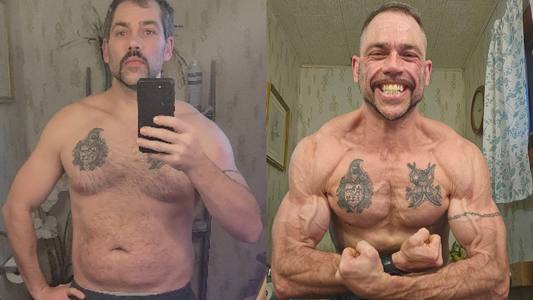

What You Should Know About Building Lean Muscle Mass
To many people, the word lean is closely connected to the concept of a healthy lifestyle. But there’s so much more to lean muscle mass than just being thin. What is lean muscle mass and how can you build up and improve these types of muscles through your workouts over time? ZOZOFIT takes a look here.
What is Lean Muscle?
Technically, all muscles are lean, but the term "lean muscle" describes muscles that have little to no fat surrounding them. Basically, think of anyone who has a chiseled six pack, and that gives you an idea of what lean muscles are. So when it comes time for you to consider lean muscle, if you want to achieve a slimmer look, you are going to need to focus on losing extra body fat.
To understand how a lean muscle differs from muscle mass in general, it helps to understand just what exactly a muscle is. In your body, you have over 600 muscles and all of them are made up of soft tissues and fibers that stretch and flex accordingly so that they can help you move your body. These are the three main types of muscles:
Skeletal muscles: Skeletal muscles that support your body weight and help you move. Skeletal muscles include three characteristics – the epimysium (outermost layer of tissue surrounding the entire muscle), the perimysium (middle layer surrounding bundles of muscle fibers), and the endomysium (innermost layer surrounding individual muscle fibers).
Smooth muscles: Smooth muscles work within your gastrointestinal, reproductive, urinary, vascular, and respiratory systems. These organs are lined with smooth muscle tissue to help them function.
Cardiac muscles: Found inside your heart, your cardiac muscles work hard to keep it pumping smoothly. They help propel your movement and act as the conductors of your body’s “engine.”
Out of these muscle groups, your skeletal muscles are the only ones that are voluntary and can be controlled by you, which makes them so crucial to focus on when you are creating your fitness routine.
The Benefits of Focusing on Building Lean Body Mass
While losing weight is a big motivator for many people, weight loss should never be your only reason for exercising. Building and improving your muscles is just as important, especially as you get older and want to stay more active – plus, strong muscles help your bones stay stronger over time as well.
To build your lean muscles so that you can minimize fat deposits around them, you should consider including certain types of exercises in your workout routine:
A good mix of endurance workouts and strength training can exercise a wide range of muscle groups and help you improve your Lean Body Mass which is a critical component of enjoying a long-term healthy lifestyle.
For those who may not know, Lean Body Mass is associated with your Basal Metabolic Rate (BMR), which is the amount of calories you burn at rest. So, the greater amount of Lean Body Mass that you have, the greater your BMR will be. What this means is that people with greater amounts of Lean Body Mass will have a greater energy expenditure while doing nothing, helping to avoid calorie imbalances, and can also help with any weight loss goals that you may have.
Having a good Lean Body Mass can help protect against your bones becoming weaker or thinner over time. What is beneficial about optimizing your Lean Body Mass is that you can increase bone strength and density which can keep you safer when you are older, which is a time when many people are prone to falls and bone-related injuries. Many of these injuries are tied to Sarcopenia, which is the age-related loss of skeletal muscle mass.
Sarcopenia is a well-established factor associated with decreases in muscle strength and impaired mobility when you are in an advanced age. The potential consequences of sarcopenia include frailty, physical disability, or even the reduced ability to cope with major illnesses. This means that by focusing on your Lean Body Mass now, you are helping to ensure that you can continue to be healthy regardless of your age.
5 Tips for Building Lean Muscle Mass
To begin building your lean muscle mass, there are several things you should keep in mind as you create your fitness routine. These considerations include:
Increasing Your Workout Frequency
Exercising twice a week is good if you are looking to maintain the muscle mass that you already have. But if you want to improve your lean muscle mass, or you are even looking to bulk up a bit, you should definitely consider increasing your training frequency to 4-5 times per week. You should notice changes in your muscles in just a few weeks.
Staying Consistent
While it’s always important to change up your training approaches frequently so that you can avoid fitness plateaus, it’s also just as important to stick with a training program long enough to reap its benefits, too. By allowing your body to improve its strength and efficiency through consistent training, that repetition can be hugely advantageous, especially for workout newbies. And once you begin to notice that your workouts aren’t challenging you as much as they were when you started, then it’s time to mix things up.
Try Big Lifts
If you’re not a bodybuilder, do not get intimidated by the concept of big lifts. Studies have shown that the compound movements in big lift activities like squats, deadlifts, overhead presses, and pull-ups rely on a number of muscles and deliver a lot of lean muscle mass results in an efficient manner. So when you are starting off, be sure to take it slow – you don’t want to hurt yourself – and then gradually increase the weight load as these lifts get easier and easier.
Incorporate Targeted Isolation Movements
Even though big lifts can get the job done when it comes to increasing your lean muscle mass, that doesn’t mean that you should avoid doing isolation movements like biceps curls, chest flyes, or calf raises during your workout. These types of exercises can be pivotal in building muscle and shedding fat, and because you can’t overload yourself with weight like you can when you are doing deadlifts, you’ll be able to recover from them much more quickly than big lift activities.
Don’t Forget About Life Outside of Your Fitness Routine
What you do beyond your workouts is also key to ensure that your muscles are able to properly repair themselves, shed fat, and even grow. Make sure that you take into account proper recovery time in between your workouts, and also keep your nutritional needs in mind too after your workouts so that your body is getting the fuel it needs to keep going.
Sleep is also another component of your recovery process that you should prioritize as well, as that dormant time helps get your muscles ready for whatever is next and can even improve your overall body composition.
Track Your Lean Muscle Progress with ZOZOFIT
As you stay focused on building your lean muscle mass, ZOZOFIT can help you achieve your fitness goals. By using our 3D body scanning app, you can track changes to your body and even utilize our side-by-side scan comparison function so that you can determine where you are making progress with your lean muscle improvements.
The ZOZOFIT app also calculates your body fat percentage so that you can keep tabs on your body composition, and our ColorMetric feature helps you visualize changes to your shape over time in new ways.

![zf-w-[168px] zf-h-[40px]](http://zozofit.com/cdn/shop/t/15/assets/logo-desktop.png?v=117713855448369080381753069598)




